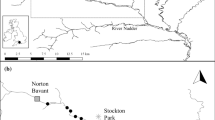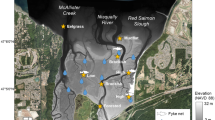Abstract
Stakeholders within the Yakima River Basin expressed concern over impacts of climate change on mid-Columbia River steelhead (Oncorhynchus mykiss), listed under the Endangered Species Act. We used a bioenergetics model to assess the impacts of changing stream temperatures—resulting from different climate change scenarios—on growth of juvenile steelhead in the Yakima River Basin. We used diet and fish size data from fieldwork in a bioenergetics model and integrated baseline and projected stream temperatures from down-scaled air temperature climate modeling into our analysis. The stream temperature models predicted that daily mean temperatures of salmonid-rearing streams in the basin could increase by 1–2 °C and our bioenergetics simulations indicated that such increases could enhance the growth of steelhead in the spring, but reduce it during the summer. However, differences in growth rates of fish living under different climate change scenarios were minor, ranging from about 1–5 %. Because our analysis focused mostly on the growth responses of steelhead to changes in stream temperatures, further work is needed to fully understand the potential impacts of climate change. Studies should include evaluating changing stream flows on fish activity and energy budgets, responses of aquatic insects to climate change, and integration of bioenergetics, population dynamics, and habitat responses to climate change.




Similar content being viewed by others
References
Baldwin CM, Beauchamp DA, Van Tassell JJ (2000) Bioenergetic assessment of temporal food supply and consumption demand by salmonids in the Strawberry reservoir food web. Trans Am Fish Soc 129:429–450
Battin J, Wiley MW, Ruckelshaus MH, Palmer RN, Korb E, Bartz KK, Imaki H (2007) Projected impacts of climate change on salmon habitat restoration. Proc Natl Acad Sci 104:6720–6725
Beauchamp DA (2009) Bioenergetic ontogeny: linking climate and mass-specific feeding to life-cycle growth and survival of salmon. Am Fish Soc Symp 70:1–19
Beauchamp DA, Cross AD, Armstrong JL, Myers KW, Moss JH, Boldt JL, Haldorson LJ (2007) Bioenergetic responses by Pacific salmon to climate and ecosystem variation. North Pac Anadromous Fish Comm Bull 4:257–269
Beer WN, Anderson JJ (2010) Sensitivity of juvenile salmonid growth to future climate trends. River Res Appl 27:663–669
Bovee KD, Waddle TJ, Talbert C, Hatten JR, Batt TR (2008) Development and application of a decision support system for water management investigations in the upper Yakima River, Washington. U. S. Geological Survey Open File Report 2008–1251, p 289
Casola JH, Cuo L, Livneh B, Lettenmaier DP, Stoelinga MT, Mote PW, Wallace JM (2009) Assessing the impacts of global warming on snowpack in the Washington cascades. J Clim 22:2758–2772
Crozier L, Zabel RW (2006) Climate impacts at multiple scales: evidence for differential population responses in juvenile Chinook salmon. J Anim Ecol 75:1100–1109
Crozier LG, Hendry AP, Lawson PW, Quinn TP, Mantua NJ, Battin J, Shaw RG, Huey RB (2008) Potential responses to climate change in organisms with complex life histories: evolution and plasticity in Pacific salmon. Evol Appl 1:252–270
Cummins KW, Wuycheck JC (1971) Caloric equivalents for investigations in ecological energetics. International Association of Theoretical and Applied Limnology, Communication No. 18, p 158
Elsner MM, Cuo L, Voisin N, Deems JS, Hamlet AF, Vano JA, Mickelson KEB, Lee SY, Lettenmaier DP (2010) Implications of 21st century climate change for the hydrology of Washington State. Clim Chang 102:225–260
Ensign WE, Strange RJ, Moore SE (1990) Summer food limitation reduces brook and rainbow trout biomass in a southern Appalachian stream. Trans Am Fish Soc 119:894–901
Godby NA Jr, Rutherford ES, Mason DM (2007) Diet, feeding rate, growth, mortality, and production of juvenile steelhead in a Lake Michigan tributary. N Am J Fish Manag 27:578–592
Graves D, Maule A (2013) Modeling water temperature in the Satus and Toppenish Watersheds of the Yakima River Basin in Washington, USA. Clim Chang (this issue)
Hanson PC, Johnson TB, Schindler DE, Kitchell JF (1997) Fish bioenergetics 3.0 for windows. Center for Limnology, University of Wisconsin-Madison and the University of Wisconsin Sea Grant Institute. WISCU-T-97-001
Harper MP, Peckarsky BL (2006) Emergence cues of a mayfly in a high-altitude stream ecosystem: potential response to climate change. Ecol Appl 16:612–621
Hogg ID, Williams DD (1996) Response of stream invertebrates to a global-warming thermal regime: an ecosystem-level manipulation. Ecol Soc Am 77:395–407
Hubble J (1980) Stream survey of the Satus and Toppenish watersheds. Fish and Wildlife Resource Management Report, Yakima Indian Nation, p 35
Jenni K, Graves D, Hardiman J, Hatten J, Mastin M, Mesa M, Montag J, Nieman T, Voss F, Maule A (2013) Identifying stakeholder-relevant climate change impacts: a case study in the Yakima River Basin, Washington, USA. Clim Chang (this issue)
Koehler ME, Fresh KL, Beauchamp DA, Cordell JR, Simenstad CA, Seiler DE (2006) Diet and bioenergetics of lake-rearing juvenile Chinook salmon in Lake Washington. Trans Am Fish Soc 135:1580–1591
Martin SW, Pearsons TN (1994) Age and growth of rainbow trout in the upper Yakima River basin. Pages 105–124 in T. N. Pearsons and five coauthors. 1994. Yakima River species interactions studies. Annual report 1993. Bonnenille Power Administration, Portland, Oregon
Mastin MC (2008) Effects of potential future warming on runoff in the Yakima River Basin, Washington. U.S. Geological Survey Scientific Investigations Report 2008–5124, p 12
McCarthy SG, Duda JJ, Emlen JM, Hodgson GR, Beauchamp DA (2009) Linking habitat quality with trophic performance of steelhead along forest gradients in the south fork Trinity River watershed, California. Trans Am Fish Soc 138:506–521
McMichael GA, Sharpe CS, Pearsons TN (1997) Effects of residual hatchery-reared steelhead on growth of wild rainbow trout and spring Chinook salmon. Trans Am Fish Soc 126:230–239
Morgan IJ, McDonald DG, Wood CM (2001) The cost of living for freshwater fish in a warmer, more polluted world. Glob Chang Biol 7:345–355
Mote PW, Salathé EP (2010) Future climate in the Pacific Northwest. Clim Chang 102:29–50
Penczak T (1985) A method of estimating total food consumption by fish populations. Hydrobiologia 123:241–244
Petersen JH, Ward DL (1999) Development and corroboration of a bioenergetics model for northern pikeminnow feeding on juvenile salmonids in the Columbia River. Trans Am Fish Soc 128:784–801
Preall RJ, Ringler NH (1989) Comparison of actual and potential growth rates of brown trout (Salmo trutta) in natural streams based on bioenergetic models. Can J Fish Aquat Sci 46:1067–1076
Railsback SF, Rose KA (1999) Bioenergetics modeling of stream trout growth: temperature and food consumption effects. Trans Am Fish Soc 128:241–256
Rand PS, Stewart DJ, Seelbach PW, Jones ML, Wedge LR (1993) Modeling steelhead population energetics in Lakes Michigan and Ontario. Trans Am Fish Soc 122:977–1001
Regonda SK, Rajagopalan B, Clark M, Pitlick J (2005) Seasonal cycle shifts in hydroclimatology over the western United States. J Clim 18:372–384
Schindler DE, Rogers DE, Scheuerell MD, Abrey CA (2005) Effects of changing climate on zooplankton and juvenile sockeye salmon growth in southwester Alaska. Ecology 86:198–209
Stewart IT, Cayan DR, Dettinger MD (2005) Changes toward earlier streamflow timing across western North America. J Clim 18:1136–1155
U.S. Bureau of Reclamation (USBR) (2002) Interim comprehensive Basin operating plan for the Yakima Project, Washington, WA; Yakima Field Office
Vano JA, Scott MJ, Voisin J, Stöckle CO, Hamlet AF, Mickelson KEB, Elsner MM, Lettenmaier DP (2010) Climate change impacts on water management and irrigated agriculture in the Yakima River Basin, Washington, USA. Clim Chang 102:287–317
Voss F, Maule AG (2013) Responding to stakeholder needs: a database-driven system for simulating water temperature in the lower Yakima River under climate change. U.S. Geological Survey Scientific Investigations Report 2013–1010, p 34
Voss FD, Curran CA, Mastin MC (2008) Modeling water temperature in the Yakima River, Washington, from Roza Diversion Dam to Prosser dam, 2005–06. U.S. Geological Survey Scientific Investigations Report 2008–5070, p 42
Western Regional Climate Center (WRCC) (2007) Desert Research Institute, Washington Climate Summaries, at http://www.wrcc.dri.edu/summary/climswa.html
Acknowledgments
We thank Frank Voss and Mark Mastin of the USGS and David Graves of the Columbia River Inter-Tribal Fish Commission for providing us with temperature data; Christopher Johnson of WDWF for diet and fish data; Chris Frederiksen of Yakama Nation Fisheries for information on salmonids in the YRB; Sally Sauter of the USGS-CRRL for discussions on bioenergetics; and Alec Maule of the USGS-CRRL for administering the project. Funding was provided by U.S. Geological Survey, Science Applications and Decision Support Program. Any use of trade names is for descriptive purposes only and does not imply endorsement by the U.S. Government.
Author information
Authors and Affiliations
Corresponding author
Additional information
J. M. Hardiman and M. G. Mesa assume equal senior authorship.
This article is part of a Special Issue on “Stakeholder Input to Climate Change Research in the Yakima River Basin, WA” edited by Alec Maule and Stephen Waste.
Rights and permissions
About this article
Cite this article
Hardiman, J.M., Mesa, M.G. The effects of increased stream temperatures on juvenile steelhead growth in the Yakima River Basin based on projected climate change scenarios. Climatic Change 124, 413–426 (2014). https://doi.org/10.1007/s10584-012-0627-x
Received:
Accepted:
Published:
Issue Date:
DOI: https://doi.org/10.1007/s10584-012-0627-x




